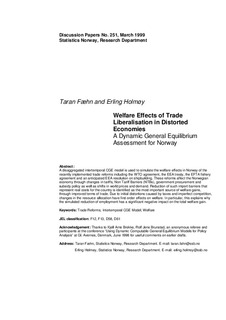| dc.contributor.author | Fæhn, Taran | |
| dc.contributor.author | Holmøy, Erling | |
| dc.date.accessioned | 2012-02-04T15:20:36Z | |
| dc.date.available | 2012-02-04T15:20:36Z | |
| dc.date.issued | 1999 | |
| dc.identifier.issn | 1892-753x | |
| dc.identifier.uri | http://hdl.handle.net/11250/180113 | |
| dc.description.abstract | A disaggregated intertemporal CGE model is used to simulate the welfare effects in Norway of the recently implemented trade reforms including the WTO agreement, the EEA treaty, the EFTA fishery agreement and an anticipated EEA resolution on shipbuilding. These reforms affect the Norwegian economy through changes in tariffs, Non Tariff Barriers (NTBs), government procurement and subsidy policy as well as shifts in world prices and demand. Reduction of such import barriers that represent real costs for the country is identified as the most important source of welfare gains, through improved terms of trade. Due to initial distortions caused by taxes and imperfect competition, changes in the resource allocation have first order effects on welfare. In particular, this explains why the simulated reduction of employment has a significant negative impact on the total welfare gain.
Keywords: Trade Reforms; Intertemporal CGE Model; Welfare | no_NO |
| dc.language.iso | eng | no_NO |
| dc.publisher | Statistics Norway, Research Department | no_NO |
| dc.relation.ispartofseries | Discussion Papers;No. 251 | |
| dc.subject | Trade reforms | no_NO |
| dc.subject | Dynamic general equilibrium model | no_NO |
| dc.subject | Norway | no_NO |
| dc.subject | Welfare effects | no_NO |
| dc.subject | JEL classification: F12 | no_NO |
| dc.subject | JEL classification: F13 | no_NO |
| dc.subject | JEL classification: D58 | no_NO |
| dc.subject | JEL classification: D61 | no_NO |
| dc.title | Welfare effects of trade liberalisation in distorted economies : a dynamic general equilibrium assessment for Norway | no_NO |
| dc.type | Working paper | no_NO |
| dc.subject.nsi | VDP::Social science: 200::Economics: 210::Economics: 212 | no_NO |
| dc.source.pagenumber | 41 s. | no_NO |
